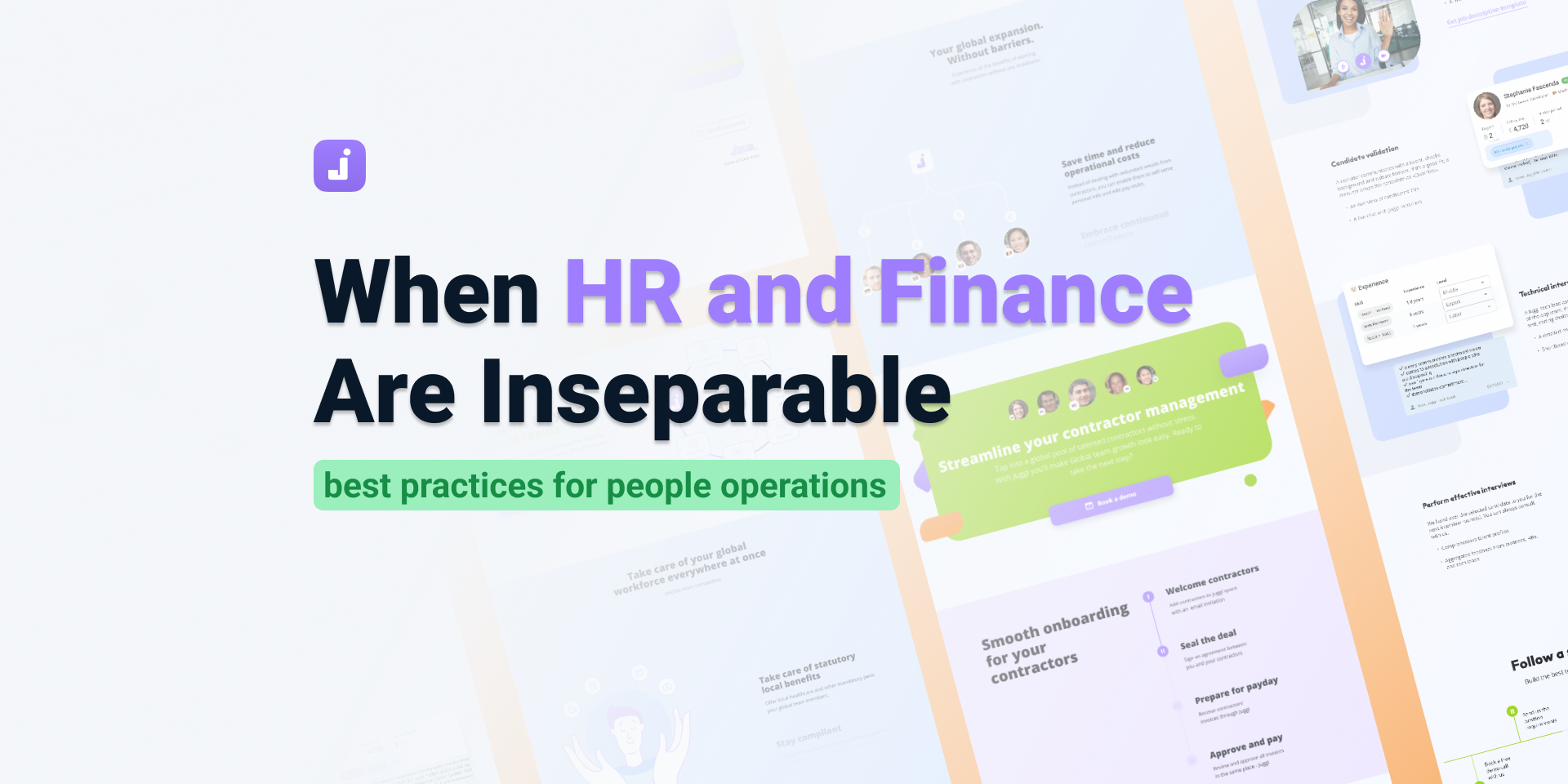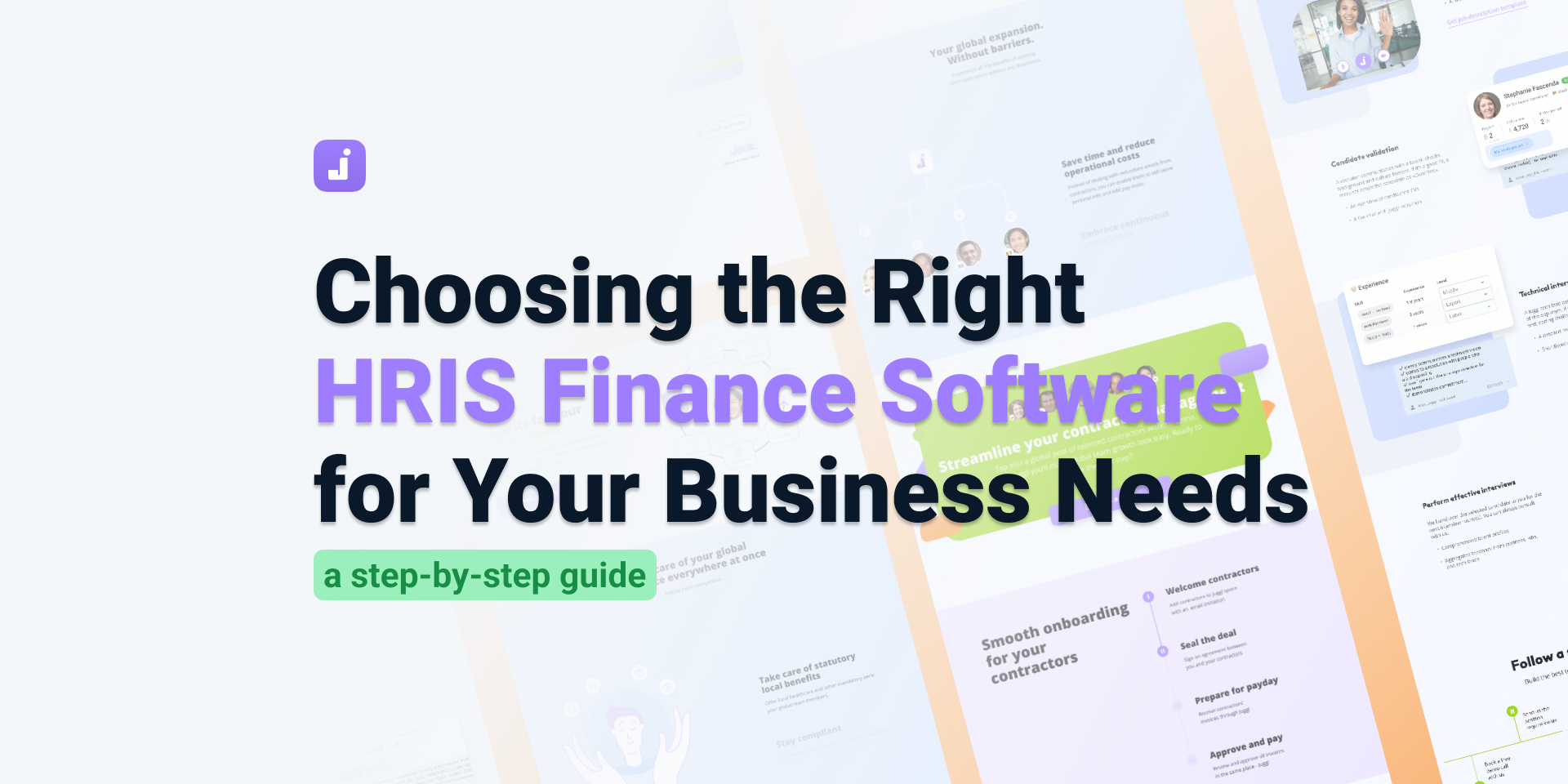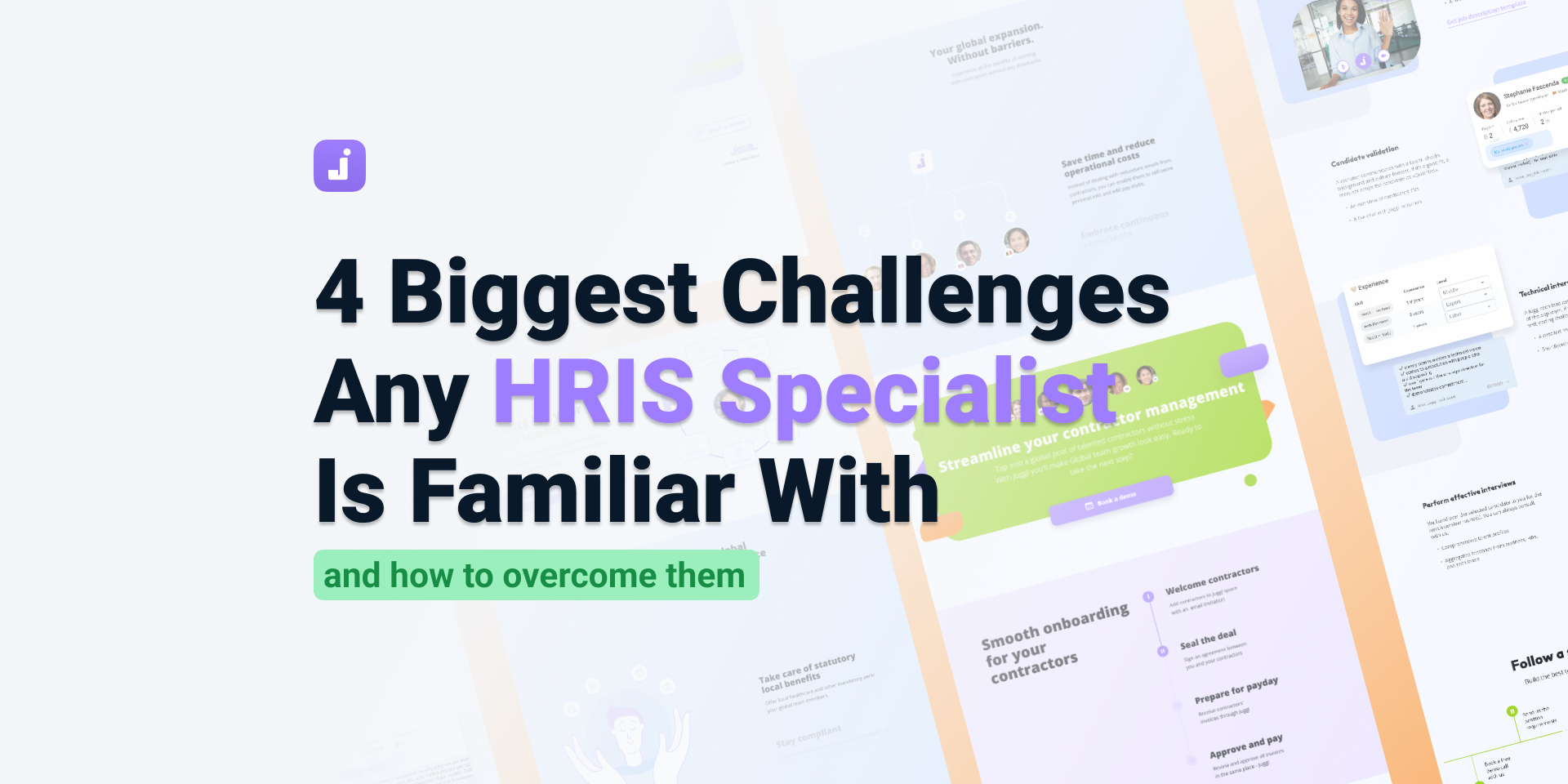What is HRIS? What You Need to Know about Efficient HR Management in 2025
In 2025, human resource management means more than managing people. Today, it's all about data, automation, and smart systems that make people operations seamless. For small businesses, startups, and growing organizations, staying efficient means adopting tools that combine all the necessary processes under one roof. Such are Human Resource Information Systems (HRIS) – these platforms bring every aspect of HR into one digital ecosystem, freeing HR teams from manual admin work and enabling them to focus on strategy and culture.
In this guide, we’ll answer the ever-relevant question: "What is an HRIS system?" We'll take a look at what really means, how it drives smarter decision-making, and what features to look for in 2025’s top systems. You’ll also see why Juggl stands out as a reliable HRIS finance tool that helps modern organizations streamline operations, stay compliant, and create better employee experiences. Keep reading to learn how technology is redefining the way HR works and how you can use it to stay ahead.
What is HRIS Software?
A Human Resource Information System (HRIS) is a software platform designed to help organizations manage their HR processes more efficiently. At its core, an HRIS centralizes employee information, and automates routine tasks while providing insights that support better decision-making. It’s essentially the backbone of modern HR operations that allows teams to move beyond spreadsheets and manual tracking.
Typically, an HRIS platform includes several key components:
- Employee data management. A centralized database to store personal details and employment history, as well as documents related to it.
- Payroll processing. Tools to manage salaries, tax deductions, benefits, and compliance with labor regulations.
- Recruitment and onboarding. Features that streamline hiring, candidate management, onboarding, and new employee orientation.
- Time and attendance tracking. Systems to monitor working hours, leaves, and absences.
- Benefits administration. Modules to manage health insurance and other employee perks.
- Reporting and analytics. Dashboards and reports that provide insights into essential HR metrics.
A good HR management software that features all these components reduces manual work, minimizes errors, and allows HR teams to focus on strategic initiatives such as culture and engagement. For small businesses, startups, and big enterprise alike, adopting an HRIS is a strategic step toward smarter, more efficient human resource management.
Key Functions of a Good HRIS in 2025
A modern HRIS is an intelligent system that connects every part of the employee lifecycle and transfers this data to other related departments. Today's best HRIS platforms are a combination of effective tools and intuitive design – together, these two create a seamless experience for HR teams and employees alike.
Reports show that companies spend an average of 15 weeks selecting the right HRIS. This equals 3.5 months, which is a significant amount of time revenue-wise. So if you're looking into HRIS systems in 2025 and want to get an optimal pick as soon as possible, here are the features we recommend paying attention to.
Employee Data Management
At the heart of every HRIS lies a centralized database that securely stores employee profiles, job history, certifications, and performance records. Advanced systems now use automation to update records in real time and maintain data integrity across departments.
Juggl is built around the idea of centralizing employee data and connecting all operational teams (specifically HR and Finance) to a single database. This creates a single source of truth for workforce information, making all processes from payroll to auditing much simpler.
Payroll Preparation and Payout Processing
Payroll is one of the most critical HRIS functions where a single error can cost critical amounts of time and money. Luckily, automation is transforming how it’s managed. A good HRIS calculates salaries automatically based on work hours, time off, compensations, and other necessary payouts. This reduces human error and ensures timely and accurate payments.
Integration with accounting tools and payment platforms further streamlines financial workflows. For example, Juggl allows you to create unified payment orders that get sent to your bank automatically – all that's left to do for you is set up a custom form and watch the system handle the paperwork for you. Thanks to permanent document storage and easy access to archived docs, Juggl helps businesses stay compliant with ever-evolving labor and tax regulations.
Time and Attendance Tracking
Accurate time tracking is essential for payroll accuracy and workforce planning. HRIS tools in 2025 use smart technologies like geolocation, biometric data, and mobile apps to monitor attendance and manage leave requests efficiently. In Juggl, employees log their work hours in their personal accounts while managers can view individual timesheets, as well as gain visibility into team availability and productivity trends in real time.
Benefits Administration and Employee Self-Service
An integrated benefits module simplifies the management of health insurance, retirement plans, and other perks. Employees can view and request their benefits directly through self-service portals, reducing HR’s administrative workload. Requests get redirected to immediate managers for approval, after which they transfer automatically into the system and get accounted while calculating the next payout.
Reporting and Analytics
Data-driven insights are what make today’s HRIS indispensable. Built-in analytics tools transform workforce data into actionable reports, empowering HR leaders to make informed, strategic decisions.
AI Features: The New Must-Have
AI has already become a household concept, and modern HRIS platforms are keeping up with the trend, offering AI features that streamline HR processes. AI can automate candidate screening, predict employee turnover, and provide personalized learning recommendations. It also powers advanced analytics, highlighting workforce trends and offering data-driven insights for better decision-making.
Key Benefits of a Good HRIS
A well-implemented HRIS has the power to transform how organizations manage their workforce. One of the biggest advantages of HRIS software is that it helps businesses cut down on manual workload, which translates into time and cost savings. If you're only getting started with an HRIS, here are the main gains you can expect:
- Your data accuracy will improve. Centralized databases reduce errors from manual entry and ensure employee information is consistent and up to date.
- HR analytics will empower smart decision-making. Built-in analytics tools turn raw data into insights, helping leaders make informed decisions about talent, which leads to a better workforce planning strategy overall.
- Your HR processes will become clearer and faster. Once you automate routine tasks like employee benefits and leave management, you'll free your HR teams' time to focus on higher-value activities.
- You'll see significant cost savings and efficiency. By reducing administrative overhead and minimizing errors, an HRIS lowers operational costs and improves overall efficiency. Juggl's smart HR automation has proved to save teams up to 20 work hours per month for healthcare companies.
- Employee engagement will increase. Self-service portals, transparent processes, and timely feedback foster better communication and a more satisfying workplace experience.
How to Perform a Smooth HRIS Integration
Selecting a good HRIS is only part of the solution. Integrating with existing tools and workflows is what can make or break the whole system's success. A well-integrated HRIS ensures that data flows seamlessly across all systems like payroll, accounting, CRM, and other operational platforms. This eliminates duplicate entries and provides managers with a comprehensive view of workforce performance.
Common Challenges in HRIS Implementation
One common issue is data migration, or transferring historical employee data into the new system. It can be complex, especially if formats differ or records are incomplete. A good HRIS is designed to make the transfer easy and error-proof.
Another challenge is system compatibility. Legacy software or third-party tools may not easily communicate with a new HRIS, requiring custom APIs or middleware. This is why it's important to choose software that gets regular updates and gets regular maintenance and technical support.
User adoption is also critical. Employees and managers may resist learning a new platform, which, quite naturally, slows down the integration process. This is why good HRIS software features user-friendly interfaces with minimal learning curve. The quicker and easier your employees adapt to the new platform, the sooner you'll get an interconnected system with smooth flows and zero missed requests.
Solutions for Smooth Integration
Addressing these challenges starts with careful planning. Audit existing systems to identify all data sources, formats, and workflows. Choose an HRIS with flexible integration options, such as pre-built connectors or open APIs.
During data migration, clean and standardize records to prevent errors. Provide training and support to ensure employees understand the new system and its benefits. Finally, implement a phased rollout rather than a “big bang” switch, allowing teams to adapt while minimizing operational disruptions.
By approaching integration thoughtfully, you can easily harness the full potential of an HRIS, ensuring data accuracy and operational efficiency of the whole ecosystem. A smooth integration not only improves HR workflows but also supports broader organizational goals in 2025 and beyond.
How to Maximize Your HRIS Efficiency
To truly benefit from the system, you need to optimize its use. We've gathered some best practices to ensure your HRIS delivers maximum value in 2025, take a look.
Regularly Clean and Update Data
Accurate data is the backbone of HRIS effectiveness. Schedule periodic audits to remove duplicates, update employee information, and correct any inconsistencies. Clean and reliable data improves reporting, analytics, and overall decision-making.
No Half-Measures
Most HRIS platforms offer automation for payroll, leave requests, onboarding, and performance tracking. Ensure these features are fully configured and tailored to your organization’s workflows. A good HRIS features unlimited customization to ensure you get what works the best for your company.
Train and Engage Employees
An HRIS is only as effective as are its users. Provide training for HR staff, managers, and, most importantly, all employees. Encourage adoption through self-service features like leave requests or benefits enrollment. Engaged users make the system more effective and reduce resistance to change.
Utilize Analytics and Reporting Tools
Modern HRIS platforms include dashboards and predictive analytics, oftentimes with AI support. Regularly review reports on turnover, performance, attendance, and workforce trends. This is your way to identify opportunities for improvement and make strategic decisions.
Review and Optimize Regularly
HR needs evolve, and so should your HRIS. Periodically review workflows and system configurations to ensure they align with current business goals. Adjust modules, automate new tasks, and implement updates to maintain peak efficiency.
Future Trends in HRIS
The HRIS landscape is constantly evolving, driven by technological advancements and changing workforce expectations. Moving ahead, we can expect HRIS platforms to become even more intelligent, adaptable, and personalized. Automation will continue to streamline routine tasks, while predictive analytics and machine learning enable smarter workforce planning and data-driven decision-making.
Modern HRIS platforms are increasingly tailored to the needs of both employees and organizations. Customizable dashboards, self-service portals, and adaptive workflows allow HR systems to fit unique company structures, supporting a more engaging and efficient experience for every user.
As HR continues to shift toward strategic, people-focused operations, staying ahead means leveraging technology that evolves with your organization. A robust HRIS like Juggl not only centralizes HR processes but also provides the insights and flexibility needed to future-proof your workforce management.
Don’t let manual processes slow your growth. Discover how Juggl’s HRIS can streamline your HR operations, enhance employee engagement, and provide actionable insights for smarter decision-making. Book a demo today to see how modern HR technology can transform your organization and set you up for success in 2025 and beyond.

.jpeg)








